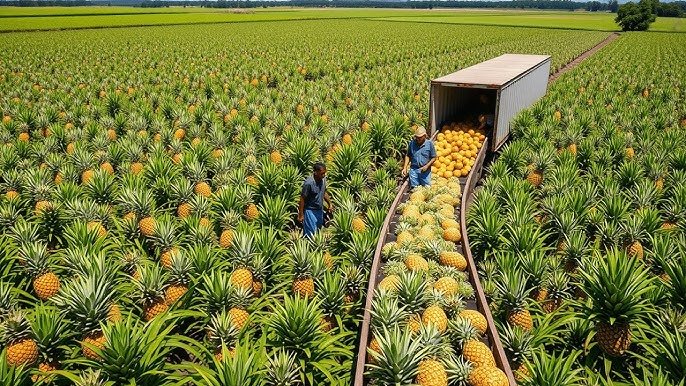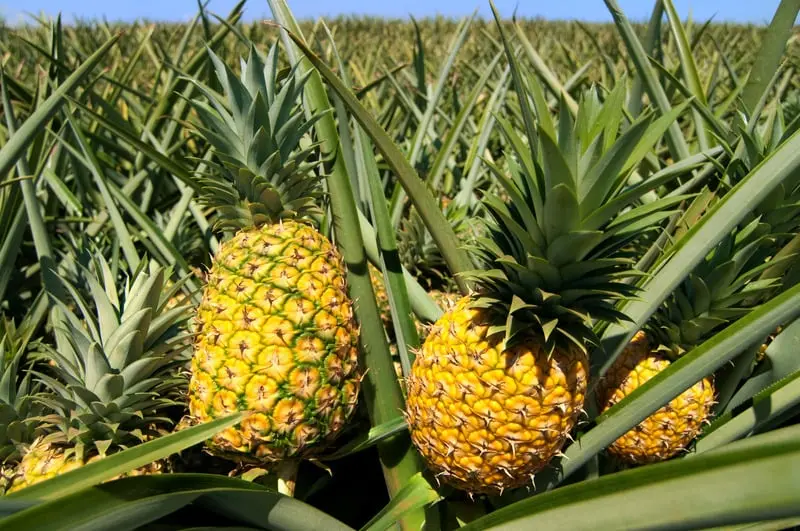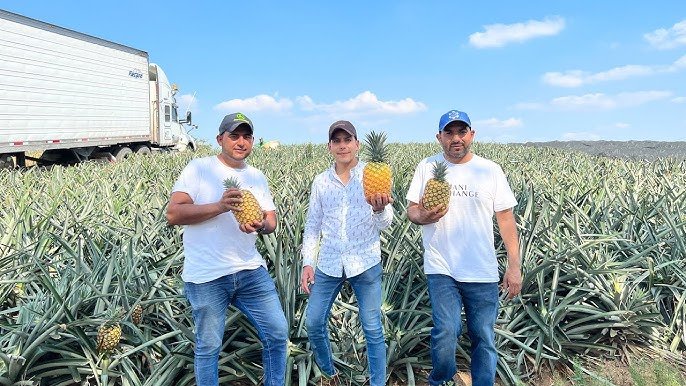Pineapples are among the most loved tropical fruits worldwide, known for their sweet, juicy flavor and aromatic fragrance. But have you ever wondered how the world’s most delicious pineapples are grown and processed? From careful cultivation to handling hundreds of thousands of tons, the journey of pineapples from farm to market is a fascinating process that combines agricultural expertise, technology, and careful handling. In this guide, we’ll explore how pineapples are produced and processed on a massive scale, ensuring quality and taste for consumers everywhere.
Why Pineapples Are So Special

Pineapples are not only delicious but also packed with nutrients:
- Rich in Vitamins and Minerals: They are a great source of Vitamin C, manganese, and antioxidants.
- Digestive Benefits: Bromelain, an enzyme in pineapples, aids digestion and reduces inflammation.
- Versatile Use: Enjoyed fresh, in juices, desserts, canned products, and even in savory dishes.
Their global popularity means that producing pineapples efficiently is essential to meet demand while maintaining taste and quality.
Step 1: Selecting the Best Pineapple Varieties

The first step in producing top-quality pineapples begins on the farm:
- Variety Selection: Farmers choose high-yield, sweet, and aromatic varieties suited to the region’s climate. Common varieties include MD-2, Queen, and Smooth Cayenne.
- Soil Suitability: Pineapples thrive in well-drained, slightly acidic soil rich in organic matter.
- Climate Consideration: They require tropical or subtropical climates with temperatures between 20–30°C (68–86°F) and moderate rainfall.
Careful selection ensures that every pineapple is sweet, juicy, and consistent in quality.
Step 2: Planting Pineapples
Pineapples are usually grown from suckers, crowns, or slips rather than seeds:
- Crowns: The leafy top of the fruit is planted directly in the soil.
- Suckers: Side shoots from the main plant are used to produce new plants.
- Slips: Smaller offshoots from the base of the pineapple plant.
Spacing is critical: plants are typically set 30–40 inches apart to allow room for growth, proper sunlight, and airflow, reducing the risk of disease.
Step 3: Caring for Pineapple Plants

Growing delicious pineapples requires patience and consistent care:
- Irrigation: Pineapples are drought-tolerant but produce better yields with consistent watering. Drip irrigation is often used for efficiency.
- Fertilization: Organic and chemical fertilizers provide essential nutrients like nitrogen, phosphorus, and potassium.
- Weed Control: Mulching and manual weeding prevent competition for nutrients.
- Pest Management: Insect pests like mealybugs and nematodes are controlled using natural or chemical solutions.
With proper care, pineapple plants take 18–24 months to produce mature, flavorful fruits.
Step 4: Harvesting Pineapples

Harvesting is a delicate process to maintain the fruit’s quality:
- Timing: Pineapples are harvested when fully ripe but firm, ensuring sweetness and longevity.
- Manual Handling: Workers carefully cut fruits using knives to avoid bruising.
- Sorting in the Field: Only healthy, damage-free pineapples are sent for processing.
On large farms, hundreds of thousands of pineapples may be harvested weekly, requiring meticulous coordination.
Step 5: Transportation from Farm to Processing Facility
Transporting pineapples efficiently is essential to maintain freshness:
- Crates and Boxes: Fruits are packed in ventilated crates to prevent crushing.
- Temperature Management: Pineapples are sensitive to heat; trucks are often cooled to reduce ripening during transport.
- Handling: Gentle handling minimizes bruising, ensuring that the fruit reaches the processing facility in perfect condition.
Efficient logistics ensure that even 140,000 tons of pineapples can be transported safely for processing.
Step 6: Processing Pineapples at Scale

Once at the facility, pineapples undergo several steps before reaching consumers:
- Washing and Cleaning: Fruits are washed thoroughly to remove dirt, pesticides, or residues.
- Sorting: Pineapples are sorted by size, color, and quality. Damaged or undersized fruits are removed.
- Peeling and Coring: Automated machines or skilled workers remove the tough outer skin and core.
- Slicing and Packaging: Depending on the product—fresh, canned, juice—pineapples are sliced, diced, or juiced.
- Canning and Preservation: For long-term storage, pineapples are canned with syrup or juice under hygienic conditions.
Modern facilities use advanced machinery and quality control to maintain taste, aroma, and nutritional value.
Step 7: Quality Control and Safety Measures
Maintaining consistency and safety is crucial:
- Hygiene Standards: Processing facilities follow strict cleanliness and sanitation protocols.
- Quality Checks: Random samples are tested for sugar content, acidity, and ripeness.
- Traceability: Each batch is recorded to ensure food safety and accountability.
These steps guarantee that consumers enjoy high-quality, delicious pineapples every time.
Step 8: Distribution to Markets
After processing, pineapples are distributed to local and international markets:
- Cold Storage: Maintains freshness during transit.
- Efficient Logistics: Coordinated supply chains ensure timely delivery.
- Retail Display: Pineapples are arranged to attract consumers while preserving their quality.
Efficient distribution ensures that delicious pineapples reach consumers around the world, maintaining the farm-to-table journey.
Benefits of Modern Pineapple Production
- High-Quality Fruit: Advanced agricultural practices improve sweetness, aroma, and texture.
- Large-Scale Efficiency: Millions of tons can be processed and distributed globally.
- Reduced Waste: Careful harvesting, handling, and processing minimize losses.
- Economic Growth: Pineapple farming supports rural economies and provides jobs.
- Consumer Satisfaction: Fresh, safe, and delicious pineapples available year-round.
By combining traditional farming knowledge with modern technology, pineapple producers deliver consistently delicious fruit on a massive scale.
Tips for Small-Scale Pineapple Growers
Even if you’re not managing 140,000 tons, you can grow delicious pineapples at home or on small farms:
- Choose high-quality planting material (crowns, slips, or suckers).
- Provide well-drained, nutrient-rich soil.
- Water regularly but avoid overwatering.
- Protect plants from pests and diseases naturally.
- Harvest at the right time for peak sweetness.
With attention to detail, even small growers can produce amazing, sweet pineapples.
Conclusion
The journey of pineapples from farm to table is a combination of patience, skill, and technology. From planting carefully selected varieties to processing hundreds of thousands of tons with precision, every step is designed to ensure the fruit’s quality, taste, and freshness. Modern agricultural technology has revolutionized pineapple production, making it possible to enjoy the world’s most delicious pineapples anywhere, anytime.
Whether you are a consumer, farmer, or food enthusiast, understanding the intricate process behind pineapple production gives a greater appreciation for this tropical fruit. The next time you enjoy a sweet, juicy pineapple, remember the careful steps—from planting, harvesting, transporting, to processing—that brought it to your plate.

Leave A Comment